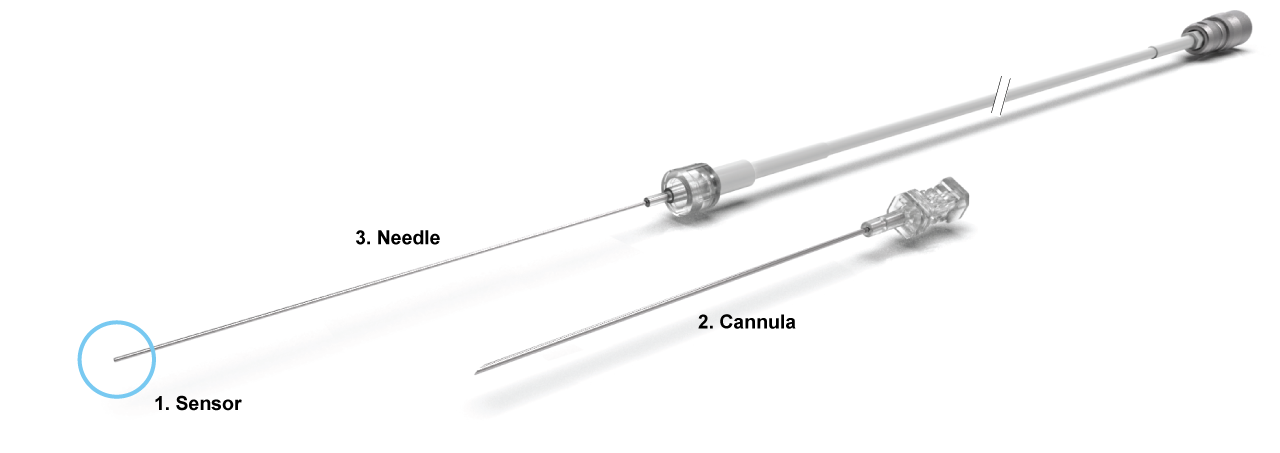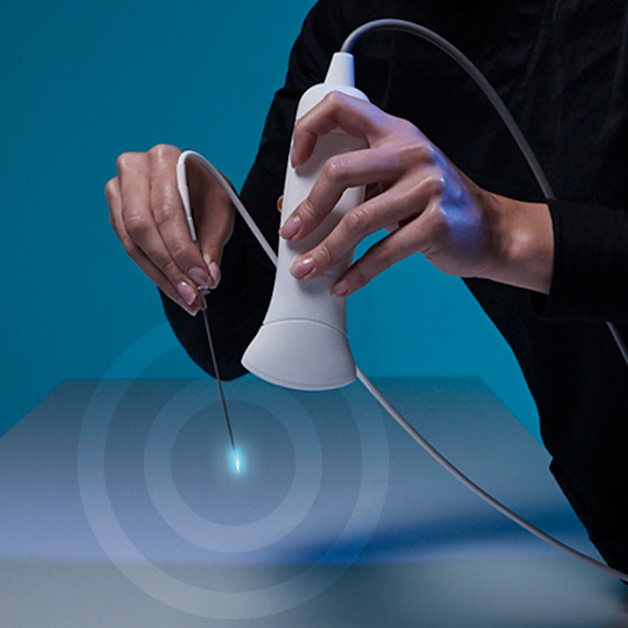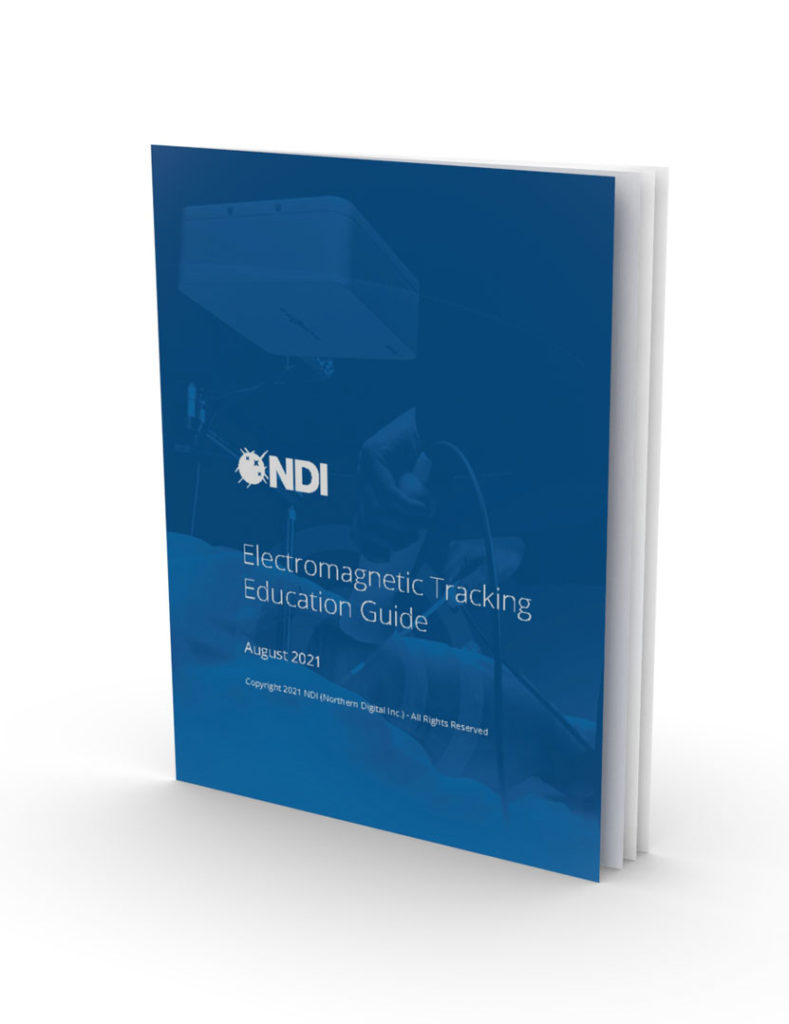3D Guidance® Training Needle
Needle-tip tracking and deflection visualization capabilities for OEM medical simulators and trainers.
Enhance Procedure Skills Development of Future Clinicians
The 3D Guidance Training Needle is an 18-gauge, 110 mm length reusable titanium needle with a micro electromagnetic sensor embedded at its tip, which enables needle-tip tracking and deflection visualization from inside the phantom. These capabilities include needle targeting and trajectory planning during simulated renal biopsies, TAP blocks, cordocentesis, spinal epidurals, and other procedures.
The 3D Guidance Training Needle is used in conjunction with the 3D Guidance electromagnetic tracking to help deliver effective OEM needle guidance training. Its integration and use in simulator or trainer workflows are similar in principle to OEM clinical applications, where the 3D Guidance solution can provide 6DOF tool tracking without line-of-sight constraints. Learn more about how EM Tracking works.
3D Guidance Training Needle Components

1. Sensor
A Model 55 Sensor is embedded at the tip of a titanium shaft. The shaft (with its encased and protected sensor) is reusable; if the shaft flexes it returns to its true position.
2. Cannula
The 18-gauge surgical steel cannula is110 mm long and features a Quincke tip. It can be used for extensive punctures before replacing.
3. Needle
The shaft (with encased sensor) is inserted into the cannula and secured with a Luer lock. The assembled needle requires no calibration.
Needle-Tip Tracking
The 3D Guidance Training Needle helps provide a training experience that realistically simulates clinical image-guided needle procedures by tracking the tip’s actual position, as opposed to having to calculate the tip offset. Needle-tip tracking allows for accurate targeting and trajectory planning during the simulated procedures by continually visualizing the needle’s depth and trajectory.
- Tip tracking is achieved via an embedded micro sensor – the same used in OEM clinical procedures.
- Enables depth and trajectory to be continually visualized, even if the needle flexes.Needle-tip tracking allows for accurate targeting and trajectory planning during the simulated procedures by continually visualizing the needle’s depth and trajectory

Deflection Visualization
The 3D Guidance Training Needle enables the needle’s angle of deflection to be visualized from inside the phantom. Deflection visualization shows the trainee if the needle has deviated from its insertion path and is now off-target, and to course-correct accordingly. It can also provide visual cues for determining the force required during puncture.
- Allows for a visual representation of the degree of needle flexion during puncture.
- Deflection visualization is calculated using two sensors: one at the needle’s tip and another at the proximal end.
Durable Design
The 3D Guidance Training Needle consists of a Model 55 Sensor embedded inside a titanium shaft. This shaft is inserted into a replaceable surgical steel cannula and secured by a Luer lock. Trainees can reuse the same needle repeatedly during a training session, eliminating high cannula replacement costs. The open cannula can be used with an integrated guidewire or syringe as required by the training scenario.
- Tested to perform up to 400 needle punctures on soft phantom materials.
- Designed with resilient materials that allow for moderate needle flexion.
Exceptional Accuracy
The 3D Guidance Training Needle via the 3D Guidance solution helps provide a realistic training experience featuring high measurement accuracy and low system latency consistent with image-guided surgery systems’ performance. This level of accuracy is required when targeting a small treatment area, where each precise needle movement must be visualized in the training interface.
- Following cannula replacement, tracking performance is sustained.
- High tracking accuracy and reliability foster trainee confidence – the needle performs the same every time. Consistent training tools promote consistent task development.
Simplified Integration
The 3D Guidance Training Needle—like the entire 3D Guidance tracking solution—is designed for ease and speed of integration into OEM medical simulators and trainers. The needle is a standard size for many clinical procedures, offering immediate use in equivalent training applications. The needle requires minimal configuration before use.
- Factory-calibrated – no user calibration or re-calibration necessary.
- Custom-sized needles are available.
3D Guidance Training Needle Technical Specifications
| Feature | Specification |
|---|---|
| Sensor Size | Model 55; ø0.56 mm x 12 mm |
| Cannula Size | 18 Gauge; 110 mm Length |
| Tracking Volume (based on use with 3D Guidance Mid-Range Transmitter) |
X: 160 mm to 320 mm Y: -100 mm to 100 mm Z: -100 mm to 100 mm |
| Positional Accuracy | 1.4 mm RMS*
*Based on Model 55 Sensor |
| Orientation (Roll) Accuracy | 0.5°RMS*
*Based on Model 55 Sensor |
| Needle Punctures | Up to 400 punctures of soft phantom material†
†Has not been validated on hard materials. |
| Cannula Replacements | Available in a package of 10 |
| System Requirement | 3D Guidance solution
(including trakSTAR™ or driveBAY™ Electronics Unit and Transmitter) |
| Materials Compliance | REACH, RoHS-3 |

3D Guidance®
Learn more about the core electromagnetic tracking solution and all its components.
Download our 12-page Education Guide to learn how you can integrate Electromagnetic Tracking Technology into your OEM medical devices to:
- Navigate instruments safely and reliably through complex anatomy.
- Target small treatment areas with
sub-millimeter accuracy and precision. - Visualize real-time position as well as orientation of an instrument.
- Track instruments even when they
are out of sight. - Embed micro sensors into flexible and
rigid instruments.
